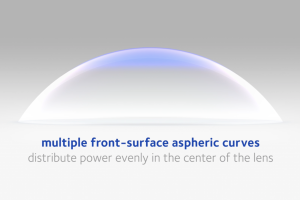A study using a new infrared imaging technique underscores the need for eye care professionals to fully correct astigmatic refractive errors of 0.75D cyl or more in soft contact lens wearers for optimal visual acuity (VA), regardless of their pupil size. Development of a novel dynamic pupil control system to evaluate the impact of uncorrected astigmatic error on visual performance (Read M, et al) is being presented at the 2022 American Academy of Optometry annual meeting this week.*
Investigators from Eurolens Research at the University of Manchester and CooperVision employed a unique Pupil Control System (PUCS) to precisely specify and control pupil size of study participants during a VA assessment, then characterize the impact of uncorrected astigmatism. Sixty eyes requiring astigmatic correction from plano to -1.50DC were each evaluated at three pupil sizes (2.5 mm, 4 mm and 5.5 mm) using full sphero-cylindrical spectacle correction, full sphero-cylindrical correction with a custom toric soft contact lens, and best sphere correction using a spherical soft contact lens.
VA was reduced with increased pupil size for all three refractive correction methods, attributed to greater aberrations as pupils enlarged. When the cylindrical power was -0.75DC or greater, uncorrected astigmatism had a statistically and clinically significant negative impact on VA between the spherical contact lens group and both the toric contact lens and spectacle groups (p<0.001, F=4.5).
“Some eye care professionals continue to fit spherical contact lenses for people with lower yet significant amounts of astigmatism. This new work adds to a sizable body of evidence[i],[ii],[iii],[iv],[v],[vi] that indicates attempting to ‘mask’ astigmatism with single vision lenses is an outdated and detrimental practice,” said Gary Orsborn, OD, MS, FAAO, FBCLA, Global Head, Post-Market Clinical Studies for CooperVision and a paper co-author. “With multiple high performing toric soft contact lenses on the market, including widely prescribed options within the CooperVision MyDay®, clariti®, and Biofinity® families, there is little reason to use spherical lenses with patients who have astigmatism of 0.75DC or greater.”
The Eurolens PUCS technology comprises a custom infrared imaging system with live image analysis software to monitor pupil size in real time. The system continuously adjusts the output of diffused LED lamps within an enclosure that surrounds the participant’s head to maintain a predetermined pupil size. This innovation is likely to be used in other research to evaluate complex optical designs for refractive correction, according to the paper authors.
Funded by CooperVision, this study joins multiple company-led and funded scientific papers and posters to be presented at the American Academy of Optometry meeting, which takes place from October 26-29 in San Diego, Calif.
[i] Wolffsohn JS, Bhogal G, Shah S. Effect of uncorrected astigmatism on vision. J Cataract Refract Surg. 2011 Mar;37(3):454-60.
[ii] Morgan PB, Efron SE, Efron N, Hill EA. Inefficacy of aspheric soft contact lenses for the correction of low levels of astigmatism. Optom Vis Sci. 2005; 82(9):823-8.
[iii] Richdale K, Berntsen DA, Mack CJ, Merchea MM, Barr JT. Visual acuity with spherical and toric soft contact lenses in low- to moderate-astigmatic eyes. Optom Vis Sci. 2007; 84(10):969-75.
[iv] Cho P, Cheung SW, Charm J. Visual outcome of Soflens Daily Disposable and Soflens Daily Disposable for Astigmatism in subjects with low astigmatism. Clin Exp Optom. 2012; 95(1):43-7.
[v] Berntsen, DA; Cox, SM; Bickle, KM; Mathew, JH; Powell, DR; Seidman, SH; Little, BK; Lorenz, KO; Nichols, JJ. A Randomized Trial to Evaluate the Effect of Toric Versus Spherical Contact Lenses on Vision and Eyestrain. Eye & Contact Lens, 2019;45: 28–33.
[vi] Chao C, Skidmore K, Tomiyama ES, Wolffsohn JS, Richdale K. Soft toric contact lens wear improves digital performance and vision—A randomised clinical trial. Ophthalmic Physiol Opt. 2022;00:1–10.








